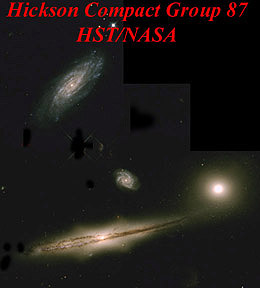The Larger scale of the Universe
A. Clusters
Until the first quarter if this century, it was commonly held that our
galaxy, the Milky Way was the only one in the universe. Since Hubble’s
discovery that some nebulae were galaxies in 1923, we have come to realize
that our spiral galaxy is but one of many and that there are as many galaxies
in this universe as there are stars in our own galaxy (100 billion roughly).
Galaxies are not evenly and randomly distributed in space, but like all
matter, they tend to group into larger, gravitationally linked systems,
clusters.
Some galaxy-rich clusters contain thousands of galaxies. Other poorer clusters,
sometimes called groups, contain only a few.
We live in such a galaxy poor cluster, the Local Group. It contains
some thirty or so galaxies, of which only three are spiral galaxies, two
giants: Andromeda (Sb) and the Milky Way (Sb), and one smaller spiral galaxy
(M33). All the others are smaller, elliptical and irregular galaxies. Andromeda
is some 2.2 million LY from us, and it and the Milky Way orbit a common
center some 1.2 million LY towards Andromeda. In contrast, the Virgo
cluster, a rich cluster over 50 million LY away in the direction of
the constellation Virgo, contains more than 2000 galaxies.
 |
To the left, is a view of a 4 galaxy group.
To the right, is a view of such a rich cluster, where every object is
a galaxy |
 |
B. Superclusters
From analysis of sky maps it is clear that rich and poor clusters form
larger assemblages called superclusters which span hundreds of millions
of LY. The supercluster to which we belong, called the Local Supercluster
is centered on the Virgo Cluster and the Local Group is on the edge of
this supercluster some 60 million LY out from its center. When we look
at the patterns of how matter is arranged in the universe across distances
of billions of light years, superclusters seem to be spaced some 400 million
LY apart, separated by large volumes of space with few, if any, galaxies:
voids.
This view of a universe populated by galaxies holds across time and
space. Below are two views of deep space taken by the Hubble Space Telescope.
They record some of the most distant galaxies ever imaged.
 |
To the left is a view of deep space in the direction of the North Celestial
Pole.
To the right is a view of deep space towards the South Celestial Pole. |
 |
|





